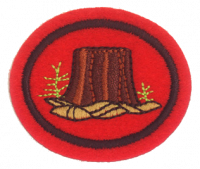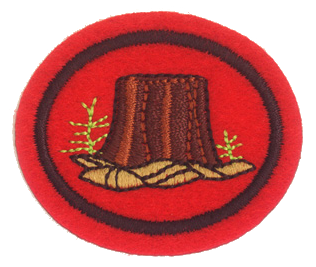Difference between revisions of "AY Honors/Forestry/Requirements"
Jomegat bot (talk | contribs) (Bot: Automated import of articles *** existing text overwritten ***) |
m |
||
| Line 1: | Line 1: | ||
{{HonorSubpage}} | {{HonorSubpage}} | ||
| − | |||
| − | |||
<section begin=Body /> | <section begin=Body /> | ||
| − | + | <b>1. <section begin=req1 /><noinclude><translate></noinclude>Have the Trees honor. | |
| − | <b>1. <section begin=req1 /><noinclude><translate></noinclude> | ||
<noinclude></translate></noinclude><section end=req1 /></b> | <noinclude></translate></noinclude><section end=req1 /></b> | ||
| − | <b>2. <section begin=req2 /><noinclude><translate></noinclude>Learn the proper use of the following common forestry tools and practice using them on trees in a forest. Record the information for each tree giving also the common name of each tree: | + | <b>2. <section begin=req2 /><noinclude><translate></noinclude>Learn the proper use of the following common forestry tools and practice using them on trees in a forest. Record the information for each tree giving also the common name of each tree: |
<noinclude></translate></noinclude><section end=req2 /></b> | <noinclude></translate></noinclude><section end=req2 /></b> | ||
| − | :<b>a. <section begin=req2a /><noinclude><translate></noinclude>DBH (diameter at breast height) tape – measure the diameter of trees (or measure the tree circumference and calculate the diameter) | + | :<b>a. <section begin=req2a /><noinclude><translate></noinclude>DBH (diameter at breast height) tape – measure the diameter of trees (or measure the tree circumference and calculate the diameter) |
<noinclude></translate></noinclude><section end=req2a /></b> | <noinclude></translate></noinclude><section end=req2a /></b> | ||
| − | :<b>b. <section begin=req2b /><noinclude><translate></noinclude>Clinometer or Tangent height gauge – measure the height of trees | + | :<b>b. <section begin=req2b /><noinclude><translate></noinclude>Clinometer or Tangent height gauge – measure the height of trees |
<noinclude></translate></noinclude><section end=req2b /></b> | <noinclude></translate></noinclude><section end=req2b /></b> | ||
| − | :<b>c. <section begin=req2c /><noinclude><translate></noinclude>Increment borer – count the growth rings to determine age | + | :<b>c. <section begin=req2c /><noinclude><translate></noinclude>Increment borer – count the growth rings to determine age |
<noinclude></translate></noinclude><section end=req2c /></b> | <noinclude></translate></noinclude><section end=req2c /></b> | ||
| Line 24: | Line 21: | ||
<noinclude></translate></noinclude><section end=req2d /></b> | <noinclude></translate></noinclude><section end=req2d /></b> | ||
| − | <b>3. <section begin=req3 /><noinclude><translate></noinclude>Use the information gathered in #2 to determine the board foot volume of the trees in the forest you measured. | + | <b>3. <section begin=req3 /><noinclude><translate></noinclude>Use the information gathered in #2 to determine the board foot volume of the trees in the forest you measured. |
<noinclude></translate></noinclude><section end=req3 /></b> | <noinclude></translate></noinclude><section end=req3 /></b> | ||
| Line 30: | Line 27: | ||
<noinclude></translate></noinclude><section end=req4 /></b> | <noinclude></translate></noinclude><section end=req4 /></b> | ||
| − | <b>5. <section begin=req5 /><noinclude><translate></noinclude>Study five tree species important to forestry in your area and give the following information about each: | + | <b>5. <section begin=req5 /><noinclude><translate></noinclude>Study five tree species important to forestry in your area and give the following information about each: |
:a. common and scientific name | :a. common and scientific name | ||
:b. range of tree | :b. range of tree | ||
| Line 38: | Line 35: | ||
<noinclude></translate></noinclude><section end=req5 /></b> | <noinclude></translate></noinclude><section end=req5 /></b> | ||
| − | <b>6. <section begin=req6 /><noinclude><translate></noinclude>List the benefits of forest to the environment, water quality, air quality, wildlife, and recreation. | + | <b>6. <section begin=req6 /><noinclude><translate></noinclude>List the benefits of forest to the environment, water quality, air quality, wildlife, and recreation. |
<noinclude></translate></noinclude><section end=req6 /></b> | <noinclude></translate></noinclude><section end=req6 /></b> | ||
Revision as of 18:25, 17 May 2021
1. Have the Trees honor.
2. Learn the proper use of the following common forestry tools and practice using them on trees in a forest. Record the information for each tree giving also the common name of each tree:
- a. DBH (diameter at breast height) tape – measure the diameter of trees (or measure the tree circumference and calculate the diameter)
- b. Clinometer or Tangent height gauge – measure the height of trees
- c. Increment borer – count the growth rings to determine age
- d. Prism – estimate the basal area per acre or hectare
3. Use the information gathered in #2 to determine the board foot volume of the trees in the forest you measured.
4. Calculate the basal area of a tree from the diameter (dbh) or circumference measurement. What is basal area per acre or hectare?
5. Study five tree species important to forestry in your area and give the following information about each:
- a. common and scientific name
- b. range of tree
- c. height and diameter of tree at maturity
- d. common use and importance of tree
- e. habitat of tree, forest zone, and elevation
6. List the benefits of forest to the environment, water quality, air quality, wildlife, and recreation.
7. List the uses of wood produced in the forests in your area, and which tree species are important for each use.
8. Discover & Discuss the following: How are forests managed to reduce the damage from insects and disease? What factors influence fire behavior? Considering that wildfires produce both benefits and destruction, what treatments could reduce wildfire severity?
9. Do one of the following in forest regeneration:
- a. Tour a forest seedling nursery
- b. Plant forest seedlings or forest seed
10. Explore the biblical stories in Genesis 1-3 and Revelation 22 that talk about the tree of life. In your discussion, discover the role of trees in God’s perfect environment, and our responsibility to take care of our environment.


